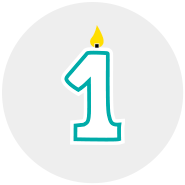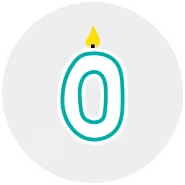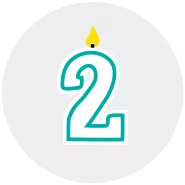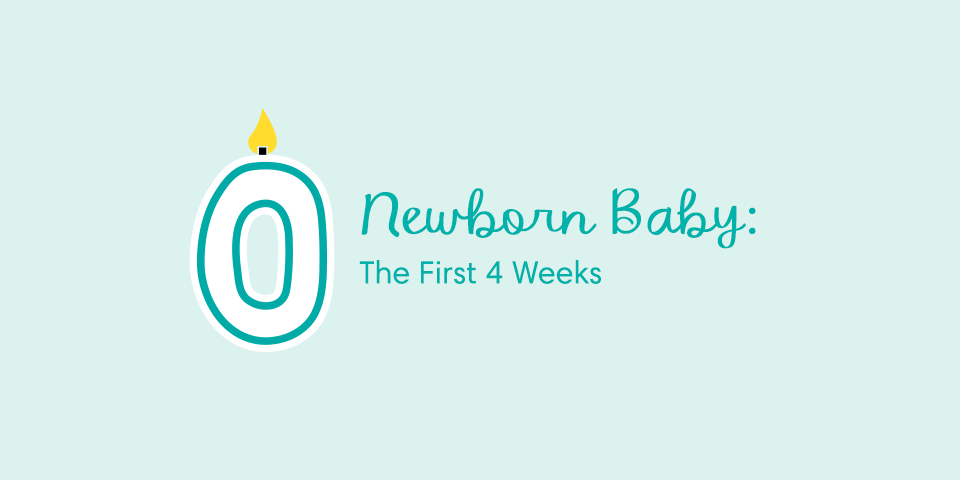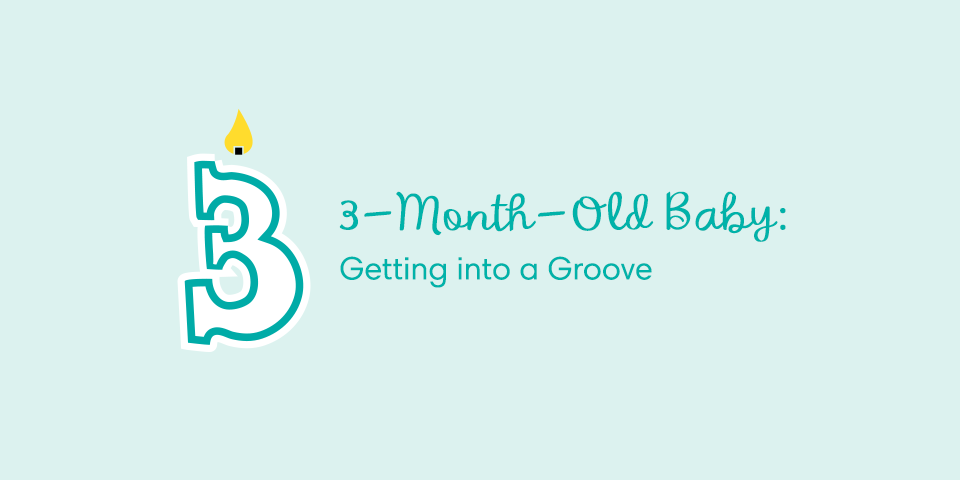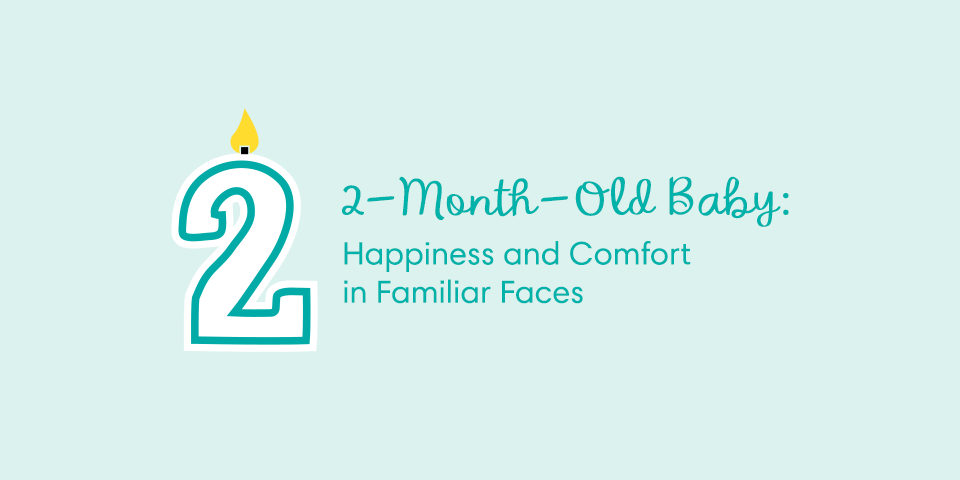Your 1-Month-Old Baby’s Development and Milestones
Key Takeaways
Having your baby at home with you in the first few weeks might have felt daunting. As the weeks progress and you gradually adjust to this new little person in your life, you'll become more confident and comfortable. Don’t get too comfortable though! Newborns grow and change rapidly, and your baby will be keeping you on your toes in weeks five, six, seven, and eight. To help you feel more prepared, we’ll outline some typical milestones for a 1-month-old baby, cover what you need to know about feeding and sleeping schedules at this stage, and give you a heads-up on potential conditions your baby might develop, like colic and cradle cap.
Baby Development Milestones for a 1-Month-Old
Your baby is unique (you knew that, of course!) and it’s normal for them to grow at their own pace. Don’t be surprised if your baby’s development in one area seems to lag for a few weeks, only for them to catch up soon after. Here are some of the baby milestones to look forward to now that your baby is 1 month old.
Growth and Physical Development: Chubby Cheeks
Does it seem as if your baby’s growing out of their clothes at supersonic speed? On average, babies gain about 1 to 1 1/2 inches in length and about 1 1/2 to 2 pounds in weight this month. At the upcoming checkup, your baby’s healthcare provider will look at your 1-month-old baby’s weight, length, and head circumference and plot these key measurements on baby growth charts. What matters is that your baby grows at a steady rate. However, your baby will go through growth spurts from time to time.
You might notice that your baby’s head is disproportionately larger than their body. This is perfectly normal: their head’s growing a little faster and their body will soon catch up. Your baby will also start to lengthen and develop stronger muscles. Luckily, they’ll still have those cute chubby cheeks for some time to come!
Senses: Eyes on That Rattle
In every waking moment, your baby is slowly taking in the sights, sounds, and smells around them. So, what can babies see at 1 month? Your baby’s vision at 1 month old is still developing, but by now they may be able to better focus on faces and track objects moving in front of them. In the next month or so they may also start to reach for objects. For example, if you hold a rattle in front of them, they may start batting at it.
Movement: Working on Those Leg Muscles
This month, most of your 1-month-old baby’s movements will still be reflexive, but some of your baby’s reflexes present in the first four weeks may gradually disappear and be replaced by more controlled movement. For example, your baby may briefly hold their head up when they're on their tummy, and they may start to stretch their arms instead of holding them close to their body.
Your baby may also start to stretch and kick their legs. It might seem like a little thing but they’re working hard to strengthen their leg muscles and improve their motor skills. Be careful: Even very young babies can roll over from time to time, so make sure you keep an eye—and hand—on them when they’re up somewhere high like a changing table.
Crying and Communication: Mom, I'm Bored (or Hungry)!
This month your baby can probably start communicating in a clearer way. If they’re bored, they may let you know by crying out until they’re shown something new. If they’re amused, they may respond by smiling. Around this time, you might also start being able to tell the difference between their hungry cries, tired cries, and irritated cries.
If you haven’t experienced it yet, this month you might see your baby’s first true smile, sometime called the social smile. They’ll flash that little grin when they’re awake, in response to something like the sound of your voice—and your heart will melt.
Activities for Supporting Your 1-Month-Old Baby’s Development
Here are some things you could try this month:
Keep in mind that there’s only so much stimulation young babies can handle. Watch for signs that your baby has had enough—they might look away or cry—and give them a chance to rest.
Feeding Your 1-Month-Old Baby
You may be wondering how often “should” a 1-month-old baby eat as they grow. It's best to continue to feed your baby whenever they seem hungry. Your 1-month-old baby’s feeding schedule may likely look like this: about eight times in a 24-hour period for babies who are breastfeeding or about every three to four hours for babies on formula. If your baby is mid-growth spurt, they may want to eat a little more often.
If you’re new to nursing, read more about the how-tos of breastfeeding and check out our go-to breastfeeding guide.
Burping Your Baby
Babies can swallow air when they feed—more often when they’re bottle-fed than when nursing. This swallowed air can make them feel uncomfortable and fussy. To help ease their discomfort, burp your baby during bottle feeds, or when you switch them from one breast to the other. Try one of the burping positions and techniques listed below, using a burp cloth or a small blanket to protect your clothes from spit-up:
Tracking Wet and Dirty Diapers
At this stage, babies may produce about four to six wet diapers a day. If you’re wondering what “should” a 1-month-old baby’s poop look like, know that there is a wide range of “normal” baby poop. And, when it comes to your 1-month-old baby’s poop frequency, even that can vary from baby to baby.
Most babies will have at least one bowel movement a day, but some babies may go several days or a week without pooping. This is likely OK as long as the consistency of the stool is normal—in other words, soft and a little runny—and your 1-month-old baby is eating well and gaining weight. Consult your baby’s healthcare provider if you think your baby may be producing too few wet or soiled diapers, which may indicate your 1-month-old baby is eating less than usual.
Given all the diaper-changing going on in your life, you deserve a reward! Download the Pampers Rewards app and start earning Pampers cash, earn $10 reward after 10 diaper scans. Not only that, but the app can also help you keep track of your baby’s development and provide useful insights to help guide you in your parenting journey.
A 1-Month-Old’s Sleep Schedule: How Much Sleep Does Your Baby Need?
If you’re wondering how much “should” your 1-month-old baby sleep, by around 4 weeks of age many babies sleep about 14 to 17 hours a day—including roughly five daytime naps. However, every baby is different. With some luck, your baby might start sleeping for longer stretches overnight from about 6 weeks of age, though your 1-month-old baby sleeping through the night is still a ways off.
If you're feeling super tired, take heart: Over time, your baby’s natural biological sleep cycle will emerge, but for now it’s important to allow your baby to sleep whenever they’re drowsy. A key point to remember: Always put your baby to sleep on their back,which can help prevent sudden infant death syndrome (SIDS).
The Fundamentals of Baby Sleep
For more insights and advice on your 1-month-old’s sleep schedule, check out the Newborn Sleep Fundamentals in the Smart Sleep Coach by Pampers app. This easy-to-use app was codeveloped with pediatricians and includes everything you need to know about the science behind babies’ sleep. Plus, it has emotional support for you, tips on creating calming bedtime routines that encourage sleep, and a proprietary algorithm that customizes sleep coaching approaches for when it comes time to help your baby, and you, sleep longer each night.
A Day in the Life of Your 1-Month-Old Baby
So, what can babies do at 1 month? Here’s an example of a typical day’s routine for a 1-month-old baby, including bathing, sleeping, feeding, and playing:
Your Baby’s Health
Some health issues you may encounter this month include:
Early Hygiene Habits: Bath Time
So, how often “should” you bathe your 1-month-old baby? Three times per week is generally recommended; bathing more frequently can dry out your baby’s skin. Learn more about cleaning your baby’s eyes, ears, and nose properly, as this is a delicate area.
When Is Crying Colic?
All babies cry from time to time, but persistent crying may be a condition called colic if
Your baby’s healthcare provider may make a diagnosis of colic if your little one cries for more than three hours a day, more than three days a week, for at least three weeks straight. Colic often starts when a baby is 2 to 4 weeks old and can last until the baby is about 3 to 4 months old.
Experts aren't sure about the cause of colic, but some potential factors could include:
Although colic usually lasts only a few months, this can seem like a lifetime when your baby is in the middle of a crying spell! Sometimes, nothing will seem to work to calm them and your nerves may become frayed.
Never Shake Your Baby!
If you are feeling overwhelmed and frustrated, put your baby in a safe location, such as their crib, for a short time and take a break in another room, or ask a loved one to care for them for a few hours so you can have some much-deserved me time. With colic, there is an end in sight; in a few months or so those colicky crying spells will likely stop.
Regular Health Visits and Immunizations
Regular checkups at this early stage typically take place when your baby turns 1 month old and again when they’re 2 months old. Of course, you can call your baby’s healthcare provider any time you have a question or concern, even between visits. At your baby’s regular checkups your baby’s provider will
Development Tips for Your Baby This Month
Here are some tips to help you bond with your little one and help them feel safe and secure, key components of healthy development:
Items You Will Need This Month
Whether you’ve already purchased some of the following baby products or have received them as gifts at your baby shower, these are things you may be reaching for this month:
FAQS AT A GLANCE
If you’re breastfeeding, wait until your baby is at least 1 month old to offer a pacifier. Keep in mind that it’s best to offer a pacifier after or between feeds, so as not to disrupt mealtimes. Use of a pacifier when going to sleep may help reduce the risk of SIDS. Your baby may like the pacifier as sucking can be soothing for them, but if they don’t want it, don’t force it.
Your Life as a Parent: Embrace Your Network of Family and Friends
You might be feeling more confident this month as some of the uncertainty you may have felt during the first few weeks starts to fade away. Still, talk about any concerns you have with trusted loved ones or your healthcare provider. You might be surprised how much better you feel afterward.
If you're breastfeeding, you might experience discomfort resulting from a breast infection called mastitis. Contact your healthcare provider if you notice symptoms such as sore breasts, fever, or nausea. Don’t stop nursing as this will make things worse. Keep in mind that it’s safe for your baby to nurse when you have mastitis—the milk is not infected.
Treatment for mastitis includes expressing milk from your breasts either by feeding or pumping, but your provider may also recommend antibiotics. Get plenty of rest and drink lots of water to help your body fight the infection. Learn more about what mastitis is and how to treat it.
Checklist for This Month
□ If you haven’t already been to the appointment, schedule and take your baby to their 1-month-old health checkup.
□ Keep track of any questions or concerns you have so you don't forget to bring them up at your next visit. Among other things, your baby's healthcare provider will want to know about your baby’s
□ Sign up for a baby first-aid course and encourage others who care for your baby to attend along with you. If you’re unsure where to find such a course near you, ask your baby’s healthcare provider—they’ll know one in your local area.
□ If you’re eager to know what’s ahead next month, take a look at what you might experience once your baby is 2 months old.
□ Your baby will be 2 months old soon. Why not download these milestone cards to help celebrate and share this big day with friends and family.
For even more information, sign up to get our regular emails:
How We Wrote This Article The information in this article is based on the expert advice found in trusted medical and government sources, such as the American Academy of Pediatrics and the American College of Obstetricians and Gynecologists. You can find a full list of sources used for this article below. The content on this page should not replace professional medical advice. Always consult medical professionals for full diagnosis and treatment.
- American Academy of Pediatrics. Caring for Your Baby and Young Child: Birth to Age 5, 7th ed. (New York: Bantam Books, 2019).
- KidsHealth. “Your Baby’s Hearing, Vision & Other Senses: 1 Month”
- KidsHealth. “Your Baby’s Hearing, Vision & Other Senses: 2 Months”
- KidsHealth. “Your Child’s Development: 2 Months”
- KidsHealth. “Your Baby’s Growth: 1 Month”
- KidsHealth. “Your Baby’s Growth: 2 Months”
- KidsHealth. “Your Child’s Checkup: 1 Month”
- KidsHealth. “Your Child’s Checkup: 2 Months”
- KidsHealth. “Learning, Play, and Your 1- to 3-Month-Old”
- KidsHealth. “Sleep and Your 1- to 3-Month-Old”
- KidsHealth. “Learning, Play, and Your Newborn”
- KidsHealth. “Movement, Coordination, and Your 1- to 3-Month-Old”
- KidsHealth. “Your Colicky Baby”
- KidsHealth. “Feeding Your 1- to 3-Month-Old”
- KidsHealth. “Medical Care and Your 1- to 3-Month-Old”
- KidsHealth. “Communication and Your 1- to 3-Month-Old”
- healthychildren.org. “Emotional and Social Development: Birth to 3 Months”
- healthychildren.org. “Pooping By the Numbers”
- Mayo Clinic. “Baby Bath Basics: A Parent's Guide”
